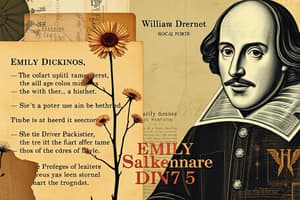Podcast
Questions and Answers
What is the train compared to when it leaves the station?
What is the train compared to when it leaves the station?
- A queen (correct)
- A servant
- A king
- A slave
What do the houses seem to be doing as the train passes them?
What do the houses seem to be doing as the train passes them?
- Singing
- Crowding (correct)
- Humming
- Dancing
What does the train pass through after leaving the station?
What does the train pass through after leaving the station?
- Gasworks and a zoo
- A station and a market
- Gasworks and a cemetery (correct)
- A park and a school
What does the train seem to be like in the open country?
What does the train seem to be like in the open country?
How does the sound of the train's horn change?
How does the sound of the train's horn change?
What does the poet say the train explores and enjoys?
What does the poet say the train explores and enjoys?
What is the final comparison the poet makes to the train?
What is the final comparison the poet makes to the train?
What does the poet say is better than the songs of birds?
What does the poet say is better than the songs of birds?
Flashcards are hidden until you start studying
Study Notes
The Train's Imagery
- The train is personified as a queen, royalty that doesn't bow or have restrictions.
- It leaves the station with an air of nonchalance, uninterested in its surroundings.
The Journey Begins
- The train passes humble houses crowded on both sides of the rail.
- It crosses the gasworks and cemetery, where gravestones symbolize death.
Entering the Open Country
- Upon reaching the countryside, the train gains speed and becomes mysterious to the poet.
- It's likened to a self-possessed ship in the ocean, shining and singing.
The Train's Song
- The train's horn starts low and grows louder, sometimes low, sometimes high, and finally, seemingly mad.
- The horn's sound echoes in curves and tunnels, revealing the joy of its tyres.
Exploring Landscapes
- The train explores new eras of white happiness while running on the rails and crossing landscapes.
- Its speed creates strange shapes, broad curves, and parallels clean on the rails.
Imaginary Journey
- The train crosses Edinburgh, Rome, and even the crest of the world in the poet's imagination.
- At night, the phosphorus brightness in the engine makes it resemble a comet.
A New Perspective
- The poet suggests that the train's song (horn) is better than birdsong, which breaks with honey buds.
- This can be seen as a direct attack on traditional Romantic Thought, prioritizing industrial progress over nature.
Studying That Suits You
Use AI to generate personalized quizzes and flashcards to suit your learning preferences.




